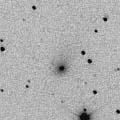
|
The brightening evolution had been slower than a typical comet since its discovery until February. However, it suddenly became bright and large in March. It was small as 10.3 mag and 1.9 arcmin on Feb. 5, but transfigured dramatically within one month as 7.8 mag and 6 arcmin on Mar. 8 (Seiichi Yoshida). It kept constant brightness visually after that, and 7.8 mag on Mar. 21 (Kamil Hornoch). On the other hand, it brightened rapidly within one month by CCD observations, from 9.4 mag on Mar. 1 to 8.0 mag on Mar. 25 (Ken-ichi Kadota). Reinder J. Bouma pointed out that the slow brightening is similar to C/1999 S4 or C/2002 O7. The current rapid brightening may be a sign of something? Unusually strong non-gravitational parameters are revealed by the orbital calculation. It keeps observable for a long time in the Southern Hemisphere after this. However, it is not observable in the Northern Hemisphere until late September when it appears very low sky at dawn as 14 mag.
Date(TT) R.A. (2000) Decl. Delta r Elong. m1 Best Time(A, h)
Apr. 9 22 33.62 -17 58.2 1.145 0.856 46 7.3 4:09 (291, -1)
Apr. 16 23 13.97 -24 52.4 1.098 0.880 49 7.3 3:58 (293,-10)
|
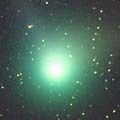
|
It was fantastic, so bright as 3.5 mag, so large as 30 arcmin, locating high overhead at its best time in early January. Then it has been getting fainter and smaller gradually, and 6.9 mag now (Mar. 31, A. Baransky). Although it became too faint to see with naked eyes, it is still easy to see with binoculars because moderately condensed as DC=5. It looks rather small with a diameter of about 10 arcmin. It is visible all night in the Northern Hemisphere. In the Northern Hemisphere, it keeps observable in good condition for a long time while the comet is bright enough visible visually until October when it becomes faint as 14 mag. It will be bright at 8.5 mag, so people can enjoy it with binoculars still in May.
Date(TT) R.A. (2000) Decl. Delta r Elong. m1 Best Time(A, h)
Apr. 9 11 38.01 73 0.5 1.175 1.648 98 7.5 22:27 (180, 52)
Apr. 16 11 51.17 69 16.9 1.253 1.718 98 7.8 22:13 (180, 56)
|
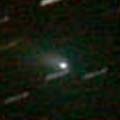
|
In January when it was visible in the Northern Hemisphere, it was an 11 mag small object. However, after it has gone to the southern sky, a very large appearance, 9.2 mag and 8 arcmin, was observed on Feb. 14 (David Seargent). The size became a bit smaller after that, about 4-5 arcmin, however, now it is so bright as 8.0 mag, bright enough to be visible with binoculars (Mar. 15, Alexandre Amorim). It becomes very low even in the Southern Hemisphere until mid May. Then it will be higher again, and keeps observable while fading gradually. In the Northern Hemisphere, it is not observable until June when it appears in the morning at 12.5 mag.
Date(TT) R.A. (2000) Decl. Delta r Elong. m1 Best Time(A, h)
Apr. 9 1 40.32 -36 49.7 1.279 0.907 44 8.2 19:54 ( 67,-35)
Apr. 16 1 44.94 -31 11.3 1.382 0.913 41 8.4 20:02 ( 76,-39)
|
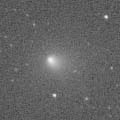
|
It was not visible visually still in February, fainter than 13.9 mag (Feb. 5, Seiichi Yoshida), however, it finally began to be visible visually at 13.3 mag in March (Mar. 1, Juan Jose Gonzalez). Although it was small with a diameter of about 1 arcmin in March, now it becomes bright as 11.8 mag and large as 2.1 arcmin (Mar. 31, A. Baransky). Strongly condensed, and easy to see. It is brightening rapidly, but fainter than originally expected by 0.5 mag. It will reach to 10 mag in spring and summer. It may become a naked-eye object due to the Deep Impact mission on July 4.
Date(TT) R.A. (2000) Decl. Delta r Elong. m1 Best Time(A, h)
Apr. 9 13 15.15 13 9.8 0.760 1.734 159 11.4 0:07 ( 0, 68)
Apr. 16 13 9.12 13 2.7 0.736 1.702 155 11.1 23:29 ( 0, 68)
|

|
It was bright as 7.5 mag in early January, easy to see with binoculars. However, it has been fading and getting diffused rapidly in the evening sky since that. It became 9 mag in early Feburary, and reached to 10.7 mag now (Mar. 15, Alexandre Amorim). Although it became faint very quickly, the fading pace was slower than usual. It is already very low in the evening sky, very faint and diffused, so hard to see. It will be unobservable soon. But it will appear in the morning sky again in August. It may be still brighter than 14 mag at that time and visible visually.
Date(TT) R.A. (2000) Decl. Delta r Elong. m1 Best Time(A, h)
Apr. 9 3 43.78 -9 42.0 3.469 2.803 41 11.6 19:54 ( 77, 2)
Apr. 16 3 47.41 -8 36.0 3.614 2.884 37 11.8 20:02 ( 82, -3)
|

|
It will reach to 10 mag in June and July. It keeps locating rather low in the morning until that. It was 14.8 mag on Mar. 17 (Ken-ichi Kadota), brightening almost as expected. Nobody has succeeded to observe it visually yet. It tends to be brighter before the perihelion passage. It will become visible visually at 13 mag soon.
Date(TT) R.A. (2000) Decl. Delta r Elong. m1 Best Time(A, h)
Apr. 9 21 25.46 11 59.4 1.861 1.536 55 12.5 4:09 (276, 30)
Apr. 16 21 48.71 13 55.9 1.784 1.474 55 12.2 3:58 (273, 30)
|
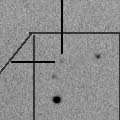
|
The condition of this return is bad. It is not observable around the perihelion passage. It will appear at dawn in July at 14.5 mag, then it will be fading after that.
Date(TT) R.A. (2000) Decl. Delta r Elong. m1 Best Time(A, h)
Apr. 9 0 12.87 -5 1.1 2.441 1.530 19 12.5 4:09 (266,-14)
Apr. 16 0 32.56 -3 20.0 2.453 1.557 20 12.6 3:58 (264,-14)
|
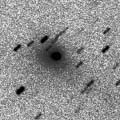
|
It was 12.4 mag on Apr. 5 (Seiichi Yoshida). It has been small at 12.5-13.0 mag since November. It will keep observable with the same appearance and brightness in the evening sky until May. But it is getting more difficult to see because getting more diffused and lower in the evening sky.
Date(TT) R.A. (2000) Decl. Delta r Elong. m1 Best Time(A, h)
Apr. 9 5 16.16 31 43.1 2.082 1.834 61 12.8 19:54 (103, 43)
Apr. 16 5 35.94 32 11.1 2.137 1.838 59 12.9 20:02 (105, 40)
|

|
It was 18.5 mag still in mid January. The brightening is slower than expected. The ephemeris says it will brighten rapidly after this, and reach to 8 mag from July to August. However, it is not observable for a while. In the Northern Hemisphere, it will appear at dawn at 11.5 mag in late May, then it keeps observable for a long time after that. In the Southern Hemisphere, it only appears in the morning very low sky from late April to mid June, but not observable when the comet is bright.
Date(TT) R.A. (2000) Decl. Delta r Elong. m1 Best Time(A, h)
Apr. 9 0 42.66 -2 18.6 2.578 1.613 12 13.4 4:09 (259,-19)
Apr. 16 0 47.79 1 4.8 2.506 1.559 15 13.1 3:58 (258,-14)
|
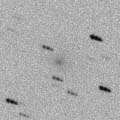
|
Michael Jager succeeded to observe the component A in the extremely low sky at dusk on Feb. 27. It was 12.0 mag, a bit brighter than its previous return. Note that the actual position is somewhat off from the prediction. The component D has not been detected yet. It has already passed 1 month after the perihelion passage, however, it still keeps bright as 12 mag (Apr. 2, Michael Jager). In its previous return, the component A became brightest about 10 days after the perihelion passage. The recent brightness seems to coincide with the trend well. The condition of this appearance is bad. In the Northern Hemisphere, it becomes highest in April, but only 19 deg high. It locates lower in the Southern Hemisphere. It will fade out very rapidly after this. It will be fainter than 16 mag at the end of April, too faint to detect on the images.
Date(TT) R.A. (2000) Decl. Delta r Elong. m1 Best Time(A, h)
Apr. 9 3 52.01 15 24.7 1.526 0.999 40 13.2 19:54 ( 96, 19)
Apr. 16 4 28.24 15 58.0 1.579 1.073 42 13.9 20:02 ( 96, 19)
|
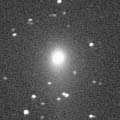
|
Although it had been rather large, well condensed, and easy to see until February, it became diffused in March. However, it still bright and large, 12.6 mag with a diameter of 2.4 arcmin on Apr. 1 (Kamil Hornoch). In the Northern Hemisphere, it keeps the same altitude at 35 deg high in the evening sky until June when it fades down to 15 mag.
Date(TT) R.A. (2000) Decl. Delta r Elong. m1 Best Time(A, h)
Apr. 9 3 12.81 68 34.6 2.771 2.505 64 13.4 19:54 (154, 33)
Apr. 16 3 49.39 69 37.0 2.841 2.551 63 13.6 20:02 (155, 34)
|
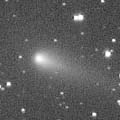
|
Although it had been strongly condensed until early January, it became diffused since late January. It is fading gradually, around 11.5 mag in January and around 12.5 mag in February. It was still bright at 12.6 mag on Mar. 8 (Seiichi Yoshida). Although the brightening evolution before the perihelion passage was extremely rapid, the fading after the perihelion passage is slow as expected. However, it became faint as 13.3 mag on Mar. 29 (A. Baransky), so it is getting hard to see visually.
Date(TT) R.A. (2000) Decl. Delta r Elong. m1 Best Time(A, h)
Apr. 9 5 26.97 17 50.8 2.676 2.395 63 13.5 19:54 ( 85, 39)
Apr. 16 5 39.88 18 4.3 2.777 2.423 59 13.7 20:02 ( 89, 35)
|
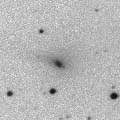
|
It brightened rapidly in January and reached to 13 mag. It was 12.8 mag, small as 0.9 arcmin, and unexpectedly rather well condensed (Mar. 8, Seiichi Yoshida). It has passed the perihelion in late February, and it is fading gradually. However, it still keeps bright as 13.2 mag on Mar. 31 (Edwin van Dijk).
Date(TT) R.A. (2000) Decl. Delta r Elong. m1 Best Time(A, h)
Apr. 9 5 40.78 24 20.4 1.529 1.455 66 13.6 19:54 ( 91, 45)
Apr. 16 6 5.82 25 46.3 1.590 1.484 65 13.7 20:02 ( 94, 44)
|

|
Not observable. It will appear at dawn again in June. It had been always brighter than 13 mag and visible visually all through the season in 2004. In 2005, it is observable in very good condition, almost overhead in the Northern Hemisphere from summer to winter. It can be a good target of observaions if it becomes active as in 2004.
Date(TT) R.A. (2000) Decl. Delta r Elong. m1 Best Time(A, h)
Apr. 9 1 6.26 15 7.3 6.729 5.738 7 13.8 4:09 (241,-12)
Apr. 16 1 11.81 15 42.2 6.730 5.739 8 13.8 3:58 (243,-10)
|

|
It was expected to be visible visually at opposition in March and April. Actually, it seems a bit fainter than expected. But it was reported as bright as 14.3 mag by CCD on Mar. 30 (Akimasa Nakamura). So it will be visible visually around 13.5 mag. Due to the retrograde orbit, it moves very fast from the morning sky to the evening sky, and immediately becomes unobservable. In the Northern Hemisphere, it locates very low in the south, so it may be impossible to see it visually. Nobody has succeeded to observe it visually yet, but it is getting higher gradually and it is best for try in April.
Date(TT) R.A. (2000) Decl. Delta r Elong. m1 Best Time(A, h)
Apr. 9 9 56.55 -22 21.1 1.249 2.051 131 14.2 20:43 ( 0, 33)
Apr. 16 9 27.57 -16 55.3 1.371 2.057 119 14.4 20:02 ( 4, 38)
|
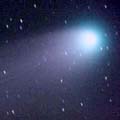
|
It kept bright as 12-13 mag visually since last November until February. It was diffused as DC=2, but bright as 12.0 mag with a diameter of 0.9 arcmin on Feb. 5 (Seiichi Yoshida). However, it had been fading on and on by CCD observations. It became so faint as 15.9 mag in late February by CCD (Feb. 27, Akimasa Nakamura), and the difference between visual and CCD observations became extremely large. However, no visual observations have been reported since Feb. 13, so it is uncertain if the comet is still visible visually or not. It keeps observable for a long time after this in the Northern Hemisphere, however, now it is low both in the evening and morning sky. It will be unobservable in the evening soon. The altitude in the morning sky keeps low around 20 deg for a while after this. Because it moves in the Milky Way for a while, it will be very hard to confirm it visually.
Date(TT) R.A. (2000) Decl. Delta r Elong. m1 Best Time(A, h)
Apr. 9 0 44.77 54 26.6 5.090 4.470 47 14.6 4:09 (214, 17)
Apr. 16 0 54.03 54 40.1 5.190 4.542 45 14.7 3:58 (215, 18)
|
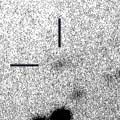
|
It has been brightening rapidly as expected, 19 mag in January and 17 mag in February. It keeps visible as bright as 12-13 mag for a long time from May to September. The condition is good in the Southern Hemisphere, but it locates very low in the Northern Hemisphere. In the previous return, it was 1.5 mag brighter than this ephemeris visually. So it can be around 11.0 mag visually at best in this return, too. It is getting bright enough to be visible visually. But it becomes lowest for the northern observers at 15 deg high from mid April to the end of June. So it will be easier to see visually in July and August.
Date(TT) R.A. (2000) Decl. Delta r Elong. m1 Best Time(A, h)
Apr. 9 15 56.65 -36 30.9 1.105 1.928 132 14.9 2:48 ( 0, 19)
Apr. 16 16 0.24 -37 37.6 1.026 1.892 137 14.6 2:24 ( 0, 17)
|
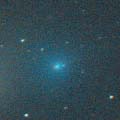
|
It was bright and large in early January, 11 mag and 2-5 arcmin, however, it has been fading rapidly as 12.5 mag in February and 13.3 mag in March. It was still visible visually on Apr. 5, but so faint as 13.8 mag (Seiichi Yoshida). It was widely diffused with a diameter of 1.8 arcmin. It will be too faint to see visually soon.
Date(TT) R.A. (2000) Decl. Delta r Elong. m1 Best Time(A, h)
Apr. 9 12 23.18 19 56.7 1.010 1.943 150 14.7 23:11 ( 0, 75)
Apr. 16 12 19.77 19 14.9 1.078 1.986 145 15.1 22:40 ( 0, 74)
|

|
It will reach to 9 mag in 2006 spring. In the Southern Hemisphere, it keeps observable until that. In the Northern Hemisphere, it is not observable until 2006 March, except it appears very low in the morning at 12 mag from late August to early September. After 2006 March, northern people can observe it for a long time while it is getting fainter. It had been brightening well as expected until early 2005.
Date(TT) R.A. (2000) Decl. Delta r Elong. m1 Best Time(A, h)
Apr. 9 4 12.34 -15 1.3 4.561 3.996 50 14.8 19:54 ( 68, 5)
Apr. 16 4 14.90 -14 47.2 4.554 3.930 46 14.7 20:02 ( 73, -2)
|
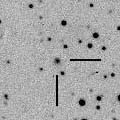
|
It brightened from 18 to 15 mag during one year from the end of 2003 to early 2005. The brightness evolution was much faster than that of a typical comet. It will become too low in the evening at 15 mag in June. Then it can be 13 mag and may be visible visually in next winter. However, after it reached to 15.2 mag in December and January at opposition, it is getting a bit fainter and 15.5 mag still in March, although it should have brighten slowly by calculation.
Date(TT) R.A. (2000) Decl. Delta r Elong. m1 Best Time(A, h)
Apr. 9 5 42.44 46 42.9 6.147 5.871 69 15.1 19:54 (123, 51)
Apr. 16 5 48.17 46 35.2 6.214 5.847 64 15.1 20:02 (124, 46)
|

|
Appearing at dawn and observed after a long time. Because there is a large difference among reported observations in 2004, the true brightness was uncertain. Actually, it was 16.0 mag (Feb. 11, Ken-ichi Kadota). It will be observable in good condition at 15 mag from April to June.
Date(TT) R.A. (2000) Decl. Delta r Elong. m1 Best Time(A, h)
Apr. 9 17 47.84 6 36.9 3.030 3.494 109 15.3 4:09 (344, 61)
Apr. 16 17 37.52 8 11.3 2.903 3.480 117 15.2 3:58 (358, 63)
|

|
New bright periodic comet discovered in 2004 spring. In last year, it had been bright at 15.0-15.5 mag from spring to summer. In this year, it is expected to be as bright as last year from spring to autumn. The ephemeris says it keeps brighter than 19 mag even around the aphelion, however, the comet had not been discovered before 2004. This suggests the comet became bright temporarily last year. But actually, it keeps the brightness for more than one year until now, 15.3 mag on Mar. 11.
Date(TT) R.A. (2000) Decl. Delta r Elong. m1 Best Time(A, h)
Apr. 9 19 55.94 -25 46.3 2.853 2.910 83 15.4 4:09 (323, 19)
Apr. 16 20 3.66 -26 1.7 2.766 2.917 88 15.4 3:58 (325, 20)
|
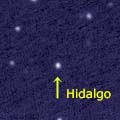
|
It reached to 13 mag and was observed visually in good condition in 2004 autumn. Then it has been fading on and on while being apart from the earth. It will be low in the evening sky at 16.5 mag in August.
Date(TT) R.A. (2000) Decl. Delta r Elong. m1 Best Time(A, h)
Apr. 9 4 46.28 61 9.6 2.281 2.096 66 15.4 19:54 (144, 42)
Apr. 16 5 19.23 60 56.8 2.341 2.122 65 15.4 20:02 (144, 42)
|

|
It brightened rapidly from 19 to 17 mag in early 2004. But it is in normal state now, 16.5 mag in early 2005. It keeps 15-16 mag for a long time until early 2007.
Date(TT) R.A. (2000) Decl. Delta r Elong. m1 Best Time(A, h)
Apr. 9 16 7.53 -19 21.0 2.489 3.280 135 15.5 2:59 ( 0, 36)
Apr. 16 16 5.64 -19 28.8 2.411 3.267 142 15.4 2:30 ( 0, 36)
|
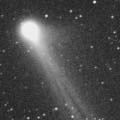
|
Fading gradually as predicted. It had been visible visually at 14 mag until January. But it became too faint to see visually after February. It will be 17 mag in June.
Date(TT) R.A. (2000) Decl. Delta r Elong. m1 Best Time(A, h)
Apr. 9 9 31.67 -6 33.8 4.284 4.936 125 15.6 20:20 ( 0, 48)
Apr. 16 9 28.26 -5 40.9 4.451 5.007 118 15.7 20:02 ( 5, 49)
|

|
Peculiar comet which becomes brightest about 5 months after the perihelion passage. It became brightest in February, about 5 months after the perihelion passage, as expected. However, it is fainter than expected in this return, and reaches to 15.5 mag at best. It was not visible visually, fainter than 14.0 mag (Feb. 5, Seiichi Yoshida).
Date(TT) R.A. (2000) Decl. Delta r Elong. m1 Best Time(A, h)
Apr. 9 10 3.35 32 51.9 2.324 2.954 119 16.0 20:52 ( 0, 88)
Apr. 16 10 4.46 32 21.1 2.418 2.971 114 16.1 20:26 ( 0, 87)
|
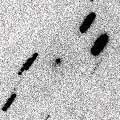
|
It came closer to the earth and reached to 15.5-16 mag by CCD observations. It looked diffused on the CCD images. So it was also visible visually at 14.3 mag (Feb. 6, Reinder J. Bouma). However, it will be getting apart from the earth after this, and getting fainter on and on.
Date(TT) R.A. (2000) Decl. Delta r Elong. m1 Best Time(A, h)
Apr. 9 8 47.68 35 33.5 1.486 1.993 104 16.4 19:54 ( 97, 86)
Apr. 16 8 59.11 32 45.1 1.559 2.014 101 16.5 20:02 ( 77, 81)
|

|
Recovery of a peculiar asteroid 2004 FS101 discovered in 2004 spring. Although it was 18 mag in mid January, it brightened to 16.7 mag in mid March. The brightness evolution was rather faster than that of a typical comet. It will be 14.5 mag around 2006 January, although it will be rather low for the northern observers. It keeps observable at 15-16 mag for a long time from 2005 spring to the end of 2006. Because it moves in the northern sky, it keeps observable for a long time in the Northern Hemisphere.
Date(TT) R.A. (2000) Decl. Delta r Elong. m1 Best Time(A, h)
Apr. 9 14 15.90 41 38.3 3.685 4.381 128 16.5 1:08 (180, 83)
Apr. 16 14 9.33 43 25.5 3.673 4.339 126 16.4 0:34 (180, 82)
|
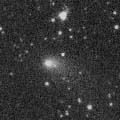
|
It had been fading rather faster than usual since the perihelion passage in 2004 spring. However, the fading turned to be slow after the end of 2004. It was already 15.4 mag on Dec. 16, then it kept almost constant brightness and 15.8 mag still on Mar. 6 (Akimasa Nakamura). It may be observable at 16 mag for a while after this.
Date(TT) R.A. (2000) Decl. Delta r Elong. m1 Best Time(A, h)
Apr. 9 9 50.83 38 4.0 3.886 4.403 114 16.7 20:39 (180, 87)
Apr. 16 9 48.59 37 3.4 4.042 4.469 108 16.8 20:10 (180, 88)
|
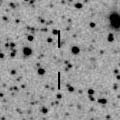
|
It will be low in the evening sky in May. It will be observable again in 2006 spring, but it will be fainter than now by 1 mag.
Date(TT) R.A. (2000) Decl. Delta r Elong. m1 Best Time(A, h)
Apr. 9 6 9.88 24 22.9 2.946 2.822 73 17.1 19:54 ( 86, 51)
Apr. 16 6 19.26 24 10.2 3.030 2.818 68 17.1 20:02 ( 90, 46)
|
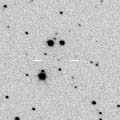
|
It was actually brighter than expected, 17.5-18 mag in March. It will keep 17.5 mag in the evening sky for a while until summer. But it will be getting lower and lower after June.
Date(TT) R.A. (2000) Decl. Delta r Elong. m1 Best Time(A, h)
Apr. 9 11 23.21 1 7.7 1.417 2.348 151 17.5 22:11 ( 0, 56)
Apr. 16 11 20.60 2 4.1 1.436 2.324 144 17.5 21:41 ( 0, 57)
|

|
Split comets. It will be fainter than 18 mag soon. The component B is fainter than A by 0.6 mag.
Date(TT) R.A. (2000) Decl. Delta r Elong. m1 Best Time(A, h)
Apr. 9 9 7.22 38 53.0 4.017 4.416 107 17.8 19:56 (180, 86)
Apr. 16 9 8.73 38 14.1 4.112 4.418 101 17.8 20:02 (119, 83)
|
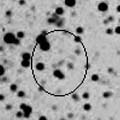
|
Because it is a far object, it has been observed at 17.5 mag for one and a half year since 2003 summer. It has already passed the perihelion, so it will become a bit fainter this year. But it keeps 18 mag until summer.
Date(TT) R.A. (2000) Decl. Delta r Elong. m1 Best Time(A, h)
Apr. 9 16 13.32 42 51.3 6.825 7.302 114 17.8 3:05 (180, 82)
Apr. 16 16 6.48 43 27.9 6.814 7.318 116 17.8 2:31 (180, 82)
|
|
![]()
 10P/Tempel 2
10P/Tempel 2 32P/Comas Sola
32P/Comas Sola 161P/2004 V2 ( Hartley-IRAS )
161P/2004 V2 ( Hartley-IRAS ) 141P/Machholz 2
141P/Machholz 2 C/2004 Q1 ( Tucker )
C/2004 Q1 ( Tucker ) 78P/Gehrels 2
78P/Gehrels 2 49P/Arend-Rigaux
49P/Arend-Rigaux 29P/Schwassmann-Wachmann 1
29P/Schwassmann-Wachmann 1 C/2004 L1 ( LINEAR )
C/2004 L1 ( LINEAR ) C/2001 Q4 ( NEAT )
C/2001 Q4 ( NEAT ) 37P/Forbes
37P/Forbes 62P/Tsuchinshan 1
62P/Tsuchinshan 1 C/2004 B1 ( LINEAR )
C/2004 B1 ( LINEAR ) C/2003 WT42 ( LINEAR )
C/2003 WT42 ( LINEAR ) C/2004 K1 ( Catalina )
C/2004 K1 ( Catalina ) P/2004 F3 ( NEAT )
P/2004 F3 ( NEAT ) (944) Hidalgo
(944) Hidalgo 117P/Helin-Roman-Alu 1
117P/Helin-Roman-Alu 1 C/2002 T7 ( LINEAR )
C/2002 T7 ( LINEAR ) 121P/Shoemaker-Holt 2
121P/Shoemaker-Holt 2 C/2004 RG113 ( LINEAR )
C/2004 RG113 ( LINEAR ) C/2005 B1 ( Christensen )
C/2005 B1 ( Christensen ) C/2003 T3 ( Tabur )
C/2003 T3 ( Tabur ) 129P/Shoemaker-Levy 3
129P/Shoemaker-Levy 3 105P/Singer Brewster
105P/Singer Brewster P/2004 V5 ( LINEAR-Hill )
P/2004 V5 ( LINEAR-Hill ) C/2003 O1 ( LINEAR )
C/2003 O1 ( LINEAR )![]()























